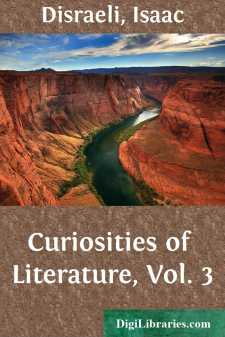Categories
- Antiques & Collectibles 13
- Architecture 36
- Art 48
- Bibles 22
- Biography & Autobiography 813
- Body, Mind & Spirit 142
- Business & Economics 28
- Children's Books 15
- Children's Fiction 12
- Computers 4
- Cooking 94
- Crafts & Hobbies 4
- Drama 346
- Education 46
- Family & Relationships 57
- Fiction 11828
- Games 19
- Gardening 17
- Health & Fitness 34
- History 1377
- House & Home 1
- Humor 147
- Juvenile Fiction 1873
- Juvenile Nonfiction 202
- Language Arts & Disciplines 88
- Law 16
- Literary Collections 686
- Literary Criticism 179
- Mathematics 13
- Medical 41
- Music 40
- Nature 179
- Non-Classifiable 1768
- Performing Arts 7
- Periodicals 1453
- Philosophy 64
- Photography 2
- Poetry 896
- Political Science 203
- Psychology 42
- Reference 154
- Religion 513
- Science 126
- Self-Help 84
- Social Science 81
- Sports & Recreation 34
- Study Aids 3
- Technology & Engineering 59
- Transportation 23
- Travel 463
- True Crime 29
Curiosities of Literature, Vol. 3
by: Isaac Disraeli
Description:
Excerpt
LOCAL DESCRIPTIONS.
Nothing is more idle, and, what is less to be forgiven in a writer, more tedious, than minute and lengthened descriptions of localities; where it is very doubtful whether the writers themselves had formed any tolerable notion of the place they describe,—it is certain their readers never can! These descriptive passages, in which writers of imagination so frequently indulge, are usually a glittering confusion of unconnected things; circumstances recollected from others, or observed by themselves at different times; the finest are thrust in together. If a scene from nature, it is possible that all the seasons of the year may be jumbled together; or if a castle or an apartment, its magnitude or its minuteness may equally bewilder. Yet we find, even in works of celebrity, whole pages of these general or these particular descriptive sketches, which leave nothing behind but noun substantives propped up by random epithets. The old writers were quite delighted to fill up their voluminous pages with what was a great saving of sense and thinking. In the Alaric of Scudery sixteen pages, containing nearly five hundred verses, describe a palace, commencing at the façade, and at length finishing with the garden; but his description, we may say, was much better described by Boileau, whose good taste felt the absurdity of this “abondance stérile,” in overloading a work with useless details,
Un auteur, quelquefois, trop plein de son objet,
Jamais sans l’épuiser n’abandonne un sujet.
S’il rencontre un palais il m’en dépeint la face,
Il me promène après de terrasae en terrasse.
Ici s’offre un perron, là règne un corridor;
Là ce balcon s’enferme en un balustre d’or;
Il compte les plafonds, les ronds, et les ovales—
Je saute vingt feuillets pour en trouver la fin;
Et je me sauve à peine au travers du jardin!
And then he adds so excellent a canon of criticism, that we must not neglect it:—
Tout ce qu’on dit de trop est fade et rébutant;
L’esprit rassasié le rejette à l’instant,
Qui ne sait se borner, ne sut jamais écrire.
We have a memorable instance of the inefficiency of local descriptions in a very remarkable one by a writer of fine genius, composing with an extreme fondness of his subject, and curiously anxious to send down to posterity the most elaborate display of his own villa—this was the Laurentinum of Pliny. We cannot read his letter to Gallus, which the English reader may in Melmoth’s elegant version, without somewhat participating in the delight of the writer in many of its details; but we cannot with the writer form the slightest conception of his villa, while he is leading us over from apartment to apartment, and pointing to us the opposite wing, with a “beyond this,” and a “not far from thence,” and “to this apartment another of the same sort,” &c. Yet, still, as we were in great want of a correct knowledge of a Roman villa, and as this must be the most so possible, architects have frequently studied, and the learned translated with extraordinary care, Pliny’s Description of his Laurentinum....


